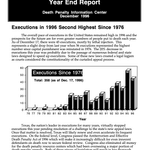The Death Penalty in 1996: Year End Report
Posted on Dec 17, 1996

OVERVIEW Top
The overall pace of executions in the United States remained high in 1996 and the prospects for the future are for even greater numbers of people put to death each year. As of December 17, there were 45 executions, mostly by lethal injection. This represents a slight drop from last year when 56 executions represented the highest number since capital punishment was reinstated in 1976. The 20% decrease in executions this year was probably due to the passage of numerous federal and state laws designed to speed up executions. Some of these new laws created a legal logjam as courts considered the constitutionality of the curtailed appeal process.
Texas, the nation’s leader in executions for many years, virtually stopped executions this year pending resolution of a challenge to the state’s new appeal laws. Once that matter is resolved, Texas will likely renew and even accelerate its frequent executions. On the federal level, Congress passed the Antiterrorism and Effective Death Penalty Act of 1996 which will make it increasingly difficult for even innocent defendants on death row to secure federal review. Congress also eliminated all money for the death penalty resource centers which had been overseeing a major portion of death penalty appeals. Both of these pieces of legislation will result in less thorough representation for those on death row.
This year, the five states with the largest death rows (California, Texas, Florida, Pennsylvania and Illinois) together were responsible for only 8 executions. But these same states have over 1,500 people on death row, indicating that the likelihood for increased executions in the near future is great.